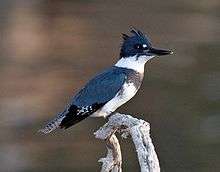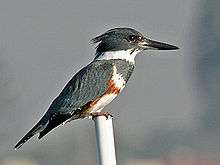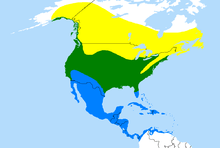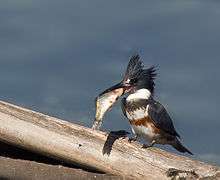Belted kingfisher
| Belted kingfisher | |
|---|---|
 | |
| Adult male | |
 | |
| Adult female | |
| Scientific classification | |
| Kingdom: | Animalia |
| Phylum: | Chordata |
| Class: | Aves |
| Subclass: | Neornithes |
| Infraclass: | Neognathae |
| Superorder: | Neoaves |
| Order: | Coraciiformes |
| Suborder: | Alcedini |
| Family: | Alcedinidae |
| Subfamily: | Cerylinae |
| Genus: | Megaceryle |
| Species: | M. alcyon |
| Binomial name | |
| Megaceryle alcyon (Linnaeus, 1758) | |
 | |
| Distribution of the belted kingfisher Breeding range Year-round range Wintering range Follows the Sibley Guide to Birds | |
| Synonyms | |
|
Ceryle alcyon | |
The belted kingfisher (Megaceryle alcyon) is a large, conspicuous water kingfisher, the only member of that group commonly found in the northern United States and Canada. It is depicted on the 1986 series Canadian $5 note. All kingfishers were formerly placed in one family, Alcedinidae, but recent research suggests that this should be divided into three subfamilies.
Description
The belted kingfisher is a stocky, medium-sized bird that measures between 28–35 cm (11–14 in) in length with a wingspan of between 48–58 cm (19–23 in). This kingfisher can weigh from 113 to 178 g (4.0 to 6.3 oz).[2][3] The adult female averages slightly larger than the adult male.
This species has a large head with a shaggy crest. Its long, heavy bill is black with a grey base. These features are common in many kingfisher species. This kingfisher shows sexual dimorphism, with the female more brightly coloured than the male. Both sexes have a slate blue head, large white collar, a large blue band on the breast, and white underparts. The back and wings are slate blue with black feather tips with little white dots. The female features a rufous band across the upper belly that extends down the flanks. Juveniles of this species are similar to adults, but both sexes feature the rufous band on the upper belly. Juvenile males will have a rufous band that is somewhat mottled while the band on females will be much thinner than that on adult females.[4]
Taxonomy and systematics
Megaceryle is from the Ancient Greek megas, "great", and the existing genus Ceryle. The specific alcyon is Latin for "kingfisher".[5]
The Megaceryle large green kingfishers were formerly placed in Ceryle with the pied kingfisher, but the latter is closer to the Chloroceryle American green kingfishers. The belted kingfisher's closest living relative is the ringed kingfisher (M. torquata), and these two in all probability originated from an African Megaceryle which colonized the Americas.[6]
Distribution and habitat
This bird's breeding habitat is near inland bodies of waters or coasts across most of Canada, Alaska and the United States. They migrate from the northern parts of its range to the southern United States, Mexico, Central America, and the West Indies in winter. It is a rare visitor to the northern areas of Colombia, Venezuela, and the Guianas.[7][8][9] During migration it may stray far from land; the species is recorded as an accidental visitor on several Pacific islands, such as Cocos Island, Malpelo Island, Hawaii, the Azores,[10] Clarion Island,[11] and has occurred as an extremely rare vagrant in Ecuador,[10] Greenland, Ireland, Netherlands, Portugal, and the United Kingdom.[1] The southernmost records of M. alcyon are from the Galapagos Archipelago, insular Ecuador, where it occurs as a migrant in small numbers but apparently not every year.[12][13][14]
It leaves northern parts of its range when the water freezes; in warmer areas it is a permanent resident. A few individuals may linger in the north even in the coldest winters except in the Arctic, if there are remaining open bodies of water.[15]
Ecology and behaviour

 |
Call
|
| Problems playing this file? See media help. | |
The belted kingfisher is often seen perched prominently on trees, posts, or other suitable "watchpoints" close to water before plunging in head first after its fish prey. They also eat amphibians, small crustaceans, insects, small mammals and reptiles.
This bird nests in a horizontal tunnel made in a river bank or sand bank and excavated by both parents. The female lays five to eight eggs and both adults incubate the eggs and feed the young.
The nest of the belted kingfisher is a long tunnel and often slopes uphill. One possible reason for the uphill slope is that, in case of flooding, the chicks will be able to survive in the air pocket formed by the elevated end of the tunnel.[16]
References
- 1 2 BirdLife International (2012). "Megaceryle alcyon". IUCN Red List of Threatened Species. Version 2013.2. International Union for Conservation of Nature. Retrieved 26 November 2013.
- ↑ Cornell Laboratories of Ornithology. "All About Birds: Belted Kingfisher". Archived from the original on 14 June 2008. Retrieved 12 June 2008.
- ↑ "Belted kingfisher videos, photos and facts – Megaceryle alcyon". ARKive. 2013-03-27. Retrieved 2013-03-31.
- ↑ Alderfer, Jonathan, ed. (2008). National Geographic Complete Birds of North America. Washington, D.C.: National Geographic. p. 362. ISBN 0-7922-4175-4.
- ↑ Jobling, James A (2010). The Helm Dictionary of Scientific Bird Names. London: Christopher Helm. pp. 40, 245. ISBN 978-1-4081-2501-4.
- ↑ Moyle, Robert G. (2006). "A Molecular Phylogeny of Kingfishers (Alcedinidae) with Insights into Early Biogeographic History.". Auk. 123 (2): 487–499. doi:10.1642/0004-8038(2006)123[487:AMPOKA]2.0.CO;2.
- ↑ Ridway, R. (1914). "The birds of North and Middle America: A descriptive catalogue of the higher groups, genera, species, and subspecies of birds known to occur in North America, from the Arctic lands to the Isthmus of Panama, the West Indies and other islands of the Caribbean Sea, and the Galapagos Archipelago. Part VI". Bulletin of the United States National Museum. 50: 1–902.
- ↑ Meyer de Schauensee, R. (1949). "The birds of the Republic of Colombia [Accipitridae–Picidae]". Caldasia. 5 (23): 381–644.
- ↑ Renaudier, A.; Comite d'Homologation de Guyane (2010). "Rare birds in French Guiana in 2005–07". Cotinga (32): 95–104.
- 1 2 Cisneros-Heredia, Diego F. (2016). "First documented record of the Belted Kingfisher Megaceryle alcyon (Linnaeus, 1758) in mainland Ecuador.". PeerJ Preprints. PeerJ. 4 (e1896v1). doi:10.7287/peerj.preprints.1896v1.
- ↑ Brattstrom, Bayard H.; Howell, Thomas R. (1956). "The Birds of the Revilla Gigedo Islands, Mexico" (PDF). Condor. Cooper Ornithological Society. 58 (2): 107–120. doi:10.2307/1364977. JSTOR 1364977.
- ↑ Lévêque, R.; Bowman, R.I.; Billeb, S.L. (1966). "Migrants in the Galápagos area". Condor. Cooper Ornithological Society. 68 (1): 81–101. JSTOR 1365177.
- ↑ Harris, M.P. (1973). "The Galápagos Avifauna". Condor. Cooper Ornithological Society. 75 (3): 265–278. doi:10.2307/1366166. JSTOR 1366166.
- ↑ Wiedenfeld, D.A. (2006). "Aves, The Galapagos Islands, Ecuador". Check List. 2 (2): 1–27. doi:10.15560/2.2.1.
- ↑ Henninger, W.F. (1906). "A preliminary list of the birds of Seneca County, Ohio" (PDF). Wilson Bulletin. 18 (2): 47–60.
- ↑ Cornell Laboratories of Ornithology. "All About Birds: Belted Kingfisher". Archived from the original on March 21, 2009. Retrieved 19 June 2009.
External links
| Wikimedia Commons has media related to Megaceryle alcyon. |
| Wikispecies has information related to: Megaceryle alcyon |
- Belted Kingfisher – Ceryle alcyon – USGS Patuxent Bird Identification InfoCenter
- "Belted Kingfisher media". Internet Bird Collection.
- Belted Kingfisher photo gallery at VIREO (Drexel University)
- Oiseaux.net Photos
- Belted Kingfisher Bird Sound at Florida Museum of Natural History
